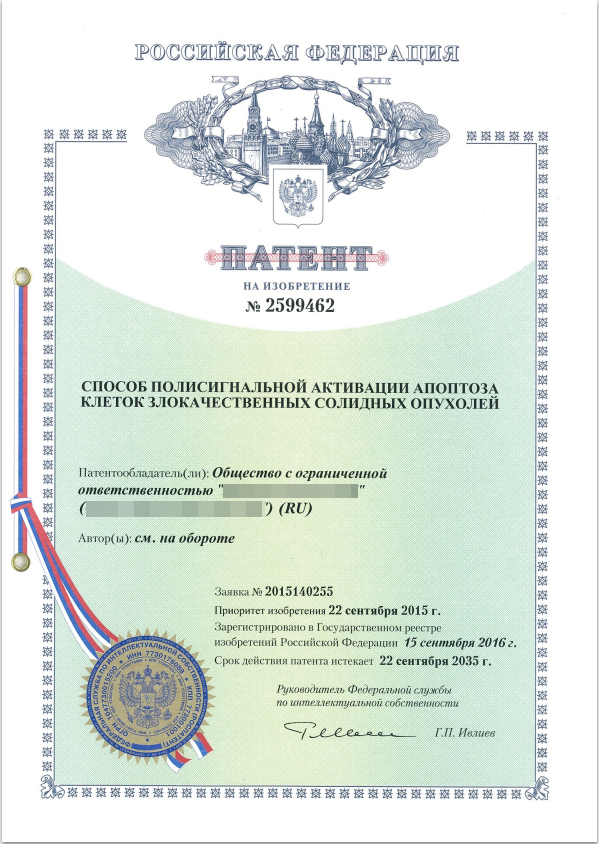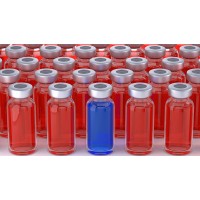Врачам
Фармакодинамика
Механизм действия препарата
Кровеносные сосуды опухоли структурно дефектны. Они часто не имеют перицитов, и их базальная мембрана слаба и дефектна. Нерегулярная структура предрасполагает опухоли к метастазу. Нерегулярная структура сосудистой сети опухоли вызывает высокое давление тканевой жидкости, которое снижает проникновение лекарства в ткань опухоли. Недостаточное проникновение лекарственного средства снижает потенциал противоопухолевой активности и заканчивается приобретенной устойчивостью к лекарству.
Нейрофилин-1 и нейрофилин-2 являются ключевыми молекулами, которые регулируют сосудистую проницаемость. Проникающие через ткань пептиды связываются с NRPs через аминокислотную последовательность RXXR/K, увеличивая транспорт молекул в опухолевую ткань. Таковым служит iRGD лиганд нацеленный на ανβ3 интегрин, специфично выраженный в сосудистой сети опухоли. Наибольшее количество ανβ3 было выявлено в меланомах, глиобластомах и саркомах, более низкий уровень экспрессии обнаружен при раке молочной железы и почечно-клеточных случаях рака. Уровни интегрина ανβ3 коррелированы с развитием болезни при некоторых злокачественных опухолях, включая: меланома, глиобластома, яичниковый рак, и рак молочной железы. Благодаря связыванию с интегрином ανβ3, iRGD лиганд приносит в сосудистую сеть опухоли лекарства – ингибиторы роста опухоли и распространение метастазов. Антиметастатические эффекты iRGD предотвращают метастазирование и преодолевают прометастатические побочные эффекты антиангиогенных методов лечения. Таким образом, iRGD обеспечивает простой способ усилить терапевтический индекс различных лекарств от рака.
Фармакокинетика
Фармакокинетические свойства ХХХ оценивались у взрослых здоровых добровольцев и у взрослых пациентов;
после многократного приема препарата наблюдалось его накопление в пределах узлов опухоли и метастазов.
Всасывание
ХХХ обладает хорошей биодоступностью при приеме внутрь. Максимальные концентрации в плазме обычно достигаются через 5-10 минут после приема препарата.
По результатам экспериментов in vitro с клетками Сасо-2 человека ХХХ не является субстратом Р-гликопротеина (помпы лекарственной устойчивости, выкачивающей из клетки различные ингибиторы).
Распределение
ХХХ в значительной степени связывается с рецептором интегрина ανβ3 (>99,9%).
Метаболизм
После однократного приема внутрь ХХХ в дозе у здоровых добровольцев большая часть действующего вещества представляла собой неизменённый препарат.
Выведение
Выведение ХХХ происходит почками. Почки играют значительную роль в выведении препарата. После однократного приема внутрь ХХХ в дозе у здоровых добровольцев в среднем 90% выделялся с мочой. Неизмененный ХХХ в кале составлял в среднем 10% от принятой дозы. Период полувыведения ХХХ при приеме в дозе у здоровых добровольцев составлял 5-7 дней, а у пациентов опухолями – 10 дней.
Период полувыведения ХХХ при приеме в дозе у здоровых добровольцев составлял 5-7 дней, а у пациентов опухолями – 10 дней.
Показания к применению
Лечение солидных опухолей в комбинации с хирургическим лечением или другими видами терапии допускается. Препарат может применяться в качестве монотерапии.
Противопоказания
- детский возраст до 18 лет
- беременность
- период лактации
- декомпенсированный цирроз печени, нарушение функции почек.
С осторожностью
Препарат Совриад® должен применяться с осторожностью:
- у пациентов с нарушением функции почек тяжелой степени (клиренс креатинина менее 30 мл/мин)
Способ применения и дозы
Рекомендуемая доза препарата 5 мл – содержимое принимать перорально 1 раз в три – пять дней, в зависимости от переносимости препарата и реакции организма на него. Тип пищи не влияет на фармакокинетические параметры ХХХ.
Побочное действие
Нежелательной реакцией, наблюдаемой при терапии препаратом, является синдром лизиса опухоли (СЛО), борьба с которым описана в соответствующих инструкциях.
Передозировка
СЛО
Меры профилактики СОЛО:
- Назначение аллопуринола.
- При лейкоцитозе более 100 тысяч в 1 мкл лейкаферез является методом выбора до начала специальной терапии, если такая возможность имеется в клинике.
- Все больные с угрозой развития уратной нефропатии должны получать гидратацию для коррекции существующего дефицита жидкости и для обеспечения форсированного диуреза в дальнейшем. Гидратация начинается с момента поступления больного в клинику до начала специального лечения. Увеличение объема выделяемой мочи, достигаемое при гидратации, уменьшает концентрацию уратов в моче. Необходим строгий контроль введенной и выделенной жидкости.
- Из-за угрозы возникновения гиперкалиемии либо из-за уже существующей гиперкалиемии в начале гидратации калий в инфузии не включается. Далее инфузия калия должна быть строго корригирована по концентрации его в крови. Допустима умеренная гипокалиемия.
- Алкализация мочи с помощью бикарбоната натрия до достижения рН мочи 7,0, но не более 7,5. При этом необходимо контролировать уровень ионизированного кальция. Коррекция дозы бикарбоната зависит от рН мочи.
- Назначение фуросемида.
- Ацетазоламид (ингибитор карбангидразы) может быть использован для усиления эффекта алкализации.
- При риске развития олигурии с профилактической целью необходимо введение микродоз дофамина.
- Ограничение энтерального питания, назначение через рот гидроокси алюминия для связывания фосфатов.
- Контроль (каждые 12 часов) уровня калия, ионизированного кальция, фосфора, мочевой кислоты, креатинина, мочевины в крови. Тщательный учет почасового диуреза, перспирации. Определение рН мочи.
- Контроль массы тела дважды в сутки.
- Ежедневный контроль уровня магния, натрия, альбумина, ЭКГ, КЩС (кислотно-щелочное состояние), СРБ (С-реактивный белок), коагулограммы.
Лечение СОЛО.
Основой лечения являются те же мероприятия, которые проводятся с целью профилактики развития СОЛО.
Гиперурекемия - увеличение объема внутривенно вводимой жидкости до 5 л/кв.м в сутки. При нормальном уровне фосфора дополнительная алкализация рН мочи может быть доведена до 7,5.
Гиперкалиемия (концентрация калия более 6 ммол/л) - начать подготовку к гемодиализу: глюкоза с инсулином, глюконат калиция, бикарбонат натрия. При концентрации калия выше 7 ммоль/л - немедленный гемодиализ.
Гиперфосфатемия - увеличение объема жидкости до 5 л/кв.м, рН мочи не более 7,0. Прекратить энтеральное питание, назначение гидроокиси алюминия через рот. При концентрации фосфора более 5 ммоль/л - гемодиализ.
Гипокалиемия - дотация кальция только при нормальной или пониженной концентрации фосфора.. Обязательный контроль уровня магния. При гипомагнеземии -введение магния.
Олиго- и анурия (диурез менее 50 мл/кв.м в час), несмотря на введение фуросемида и жидкости. Терапия: гемодиализ при уровне калия выше 6 ммоль/л. Необходимо исключить обструкцию мочеточников, инфильтрацию обеих почек.
Показания к гемодиализу:
- Уровень калия более 6 ммоль/л, несмотря на жидкостную терапию и диуретики.
- Уровень калия выше 7 ммоль/л - немедленный гемодиализ.
- Уровень фосфора выше 5 ммоль/л.
- Диурез менее 50 мл/кв.м в час при жидкостной нагрузке 130-200 мл/кв.м в час.
- Обструкция обоих мочеточников.
Коагулопатии. Лечение ДВС-синдрома (синдром диссеминированного внутрисосудистого свертывания) включает восполнение дефицита факторов свертывания - переливание свежезамороженной плазмы. При стойкой гипофибриногенемии - переливание криопреципитата фактора VIII. Часто синдром протеолиза развивается быстрее, чем рост прокоагулянтной активности и развитие ДВС- синдрома, особенно у больных с большим числом бластов на периферии. Вопрос использования гепарина или антифибринолитической терапии зависит от превалирования ДВС либо протеолитического синдрома. При тромбоэмболии легочных сосудов показано назначение урокиназы. При пневмопатии и острой дыхательной недостаточности 3 степени показана искусственная вентиляция легких.
Лечение
Специфическим антидотом является берлинская лазурь (антидот V03AB31). В случае передозировки рекомендуется проведение поддерживающей терапии (например, промывание желудочно-кишечного тракта) и наблюдение за состоянием пациента.
ХХХ характеризуется высокой степенью связывания с белками плазмы крови, поэтому гемодиализ с высокой степенью вероятности не приведет к значительному выведению ХХХ.
Срок годности
2 года
Не применять по истечении срока годности.
Условия хранения
Хранить при температуре не выше 25°С в защищенном от света месте.
Хранить в недоступном для детей месте.
Популярные Статьи
Как приготовление пищи влияет на развитие онкологии?
В настоящее время люди готовят еду разными способами. Применение газа, один из наиболее распространённых способов приготовления. Многие люди, живущие в сконцентрированном обществе, порой вынуждены гот..
Повороты судьбы и онкологические заболевания
Онкологические заболевания мира сегодня занимают вторую строчку смертности, после сердечно — сосудистых. Интересный факт, что ни сосудисто — сердечные, ни онкологичес..
Препараты для лечения рака
На сегодняшний день каждый из нас четко знает: единого и стопроцентно эффективного лекарства от рака пока не существует. Однако мнение о том, что все средства для химиотерапии и поддержания организма ..
Онкология лечится СТОпроцентно - Принцип работы
Статья опишет в общих чертах механизм, происходящий в лечение препаратом. В каждом организме млекопитающих присутствует группа клеток отвечающая за защиту организма от инфекции. Группа клеток называет..




